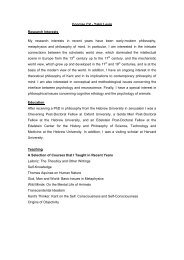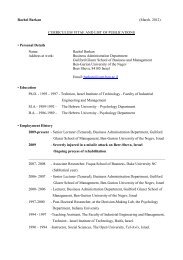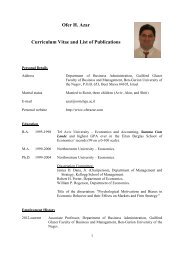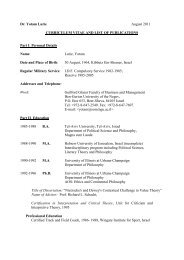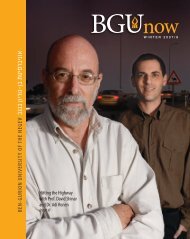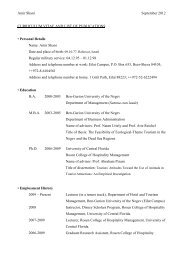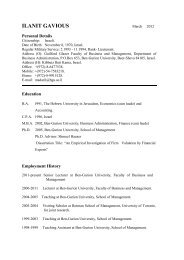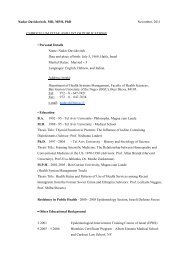Book of Abstracts
Book of Abstracts
Book of Abstracts
Create successful ePaper yourself
Turn your PDF publications into a flip-book with our unique Google optimized e-Paper software.
Application <strong>of</strong> modern technologies in rangeland research<br />
14<br />
The measurement <strong>of</strong> states and rates that are central to the functioning <strong>of</strong> rangelands are critical to<br />
research, development, monitoring and management <strong>of</strong> these systems. Modern technologies can make it<br />
possible to measure variables that could not be measured before, or introduce improvements in realms<br />
such as cost, ease, functionality, spatial and temporal resolution, accuracy and precision. They may be<br />
applied to various aspects <strong>of</strong> rangeland production systems, including climate, soil, vegetation, animal<br />
and management. Modern technologies that have been applied to rangeland research include, but are not<br />
limited to, remote sensing, GIS, GPS, spectroscopy, pedometry, acoustics, modeling and geostatistics,<br />
decision support systems and web-based applications.<br />
Temporal evolution <strong>of</strong> grasslands and open shrublands in pastoral landscapes <strong>of</strong> Greece<br />
D. Chouvardas, I. Ispikoudis, M. Siarga, K. Mitka, Ch. Evangelou and V.P. Papanastasis<br />
Laboratory <strong>of</strong> Rangeland Ecology, Aristotle University, P.O. Box 286, Thessaloniki 54124, Greece;<br />
xouv@for.auth.gr<br />
In recent years, studies <strong>of</strong> temporal evolution have been carried out in several pastoral landscapes <strong>of</strong> Greece based<br />
on aerial photographs. These studies covered a total area <strong>of</strong> 69,372 ha and included the Kolchiko and Hortiatis<br />
watersheds <strong>of</strong> central Macedonia, the Kopatsari and Askio region <strong>of</strong> western Macedonia, and the valley <strong>of</strong> Portaikos<br />
– Pertouli in Thessaly. The temporal transformation <strong>of</strong> these landscapes was evaluated by means <strong>of</strong> Geographic<br />
Informational Systems (G.I.S.) and the digitization <strong>of</strong> sequential sets <strong>of</strong> aerial photographs and orthophotos,<br />
covering a period from 1945 to 1998. Changes in grassland pattern were evaluated by the use <strong>of</strong> landscape metrics.<br />
Demographic and socioeconomic inventory data were also collected in order to explain the landscape changes. From<br />
these studies, it became evident that the pastoral landscapes have significantly changed over the last 65 years, in<br />
terms <strong>of</strong> land use/ cover structure and landscape pattern. A major trend has been the reduction <strong>of</strong> the area covered by<br />
grasslands, from 14% to 78%, during the study period in favour <strong>of</strong> forests and dense shrublands, as well as<br />
agricultural lands. Furthermore, a reduction <strong>of</strong> open shrublands in favour <strong>of</strong> dense ones was also recorded.<br />
Landscape metrics also revealed that grassland patches have become more fragmented and dispersed over the years.<br />
Population ageing, a significant decline <strong>of</strong> people employed in the primary economic sector and a change <strong>of</strong><br />
traditional management practices (animal husbandry and forestry) are considered as the main factors causing the<br />
recorded landscape changes. The reduction <strong>of</strong> grasslands and the negative prospects for their future recovery (based<br />
on a future projection model for the Kolchiko landscape) represent a major obstacle to employing sustainable<br />
practices in livestock husbandry.<br />
State <strong>of</strong> the art in monitoring the behavior and nutrition <strong>of</strong> grazing animals: the Italian and Israeli<br />
experience<br />
G. Molle 1 , E.D. Ungar 2 , A. Brosh 3 , Z. Henkin 2, 3 , M. Acciaro 1 , M. Decandia 1 and S.Y. Landau 2<br />
1 Department <strong>of</strong> Research for Animal Production, Agris Sardegna, 07040 Olmedo, Italy, gmolle@agrisricerca.it<br />
2 Department <strong>of</strong> Agronomy and Natural Resources, ARO, the Volcani Center, Bet Dagan 50250, Israel<br />
3 Beef Cattle Section, ARO, Newe Yaar Research Center, Ramat Yishay 30095, Israel<br />
The accurate monitoring <strong>of</strong> feeding behavior and nutrition <strong>of</strong> herbivores is still a challenge. This review is aimed at<br />
highlighting the pros and cons <strong>of</strong> the most widely implemented methodologies and technologies to assess and geolocate<br />
the feeding behavior and nutrition <strong>of</strong> grazers from a temporal scale <strong>of</strong> seconds to seasons and a spatial scale<br />
<strong>of</strong> cm 2 to hectares.<br />
Biting, i.e. the severing <strong>of</strong> herbage, is the key act <strong>of</strong> grazing, and bite mass is probably the most important<br />
explanatory variable <strong>of</strong> intake. It is, therefore, basic to measure the timeline <strong>of</strong> grazing and properly count the<br />
number <strong>of</strong> bites. While direct observations can be deployed with satisfactory accuracy and precision, they are timeconsuming<br />
and not always feasible. Automated measurement <strong>of</strong> grazing activity can be based on different systems,<br />
among them the IGER behavioral recorder (IBR) based on nose-band sensors <strong>of</strong> jaw movements and acoustic



